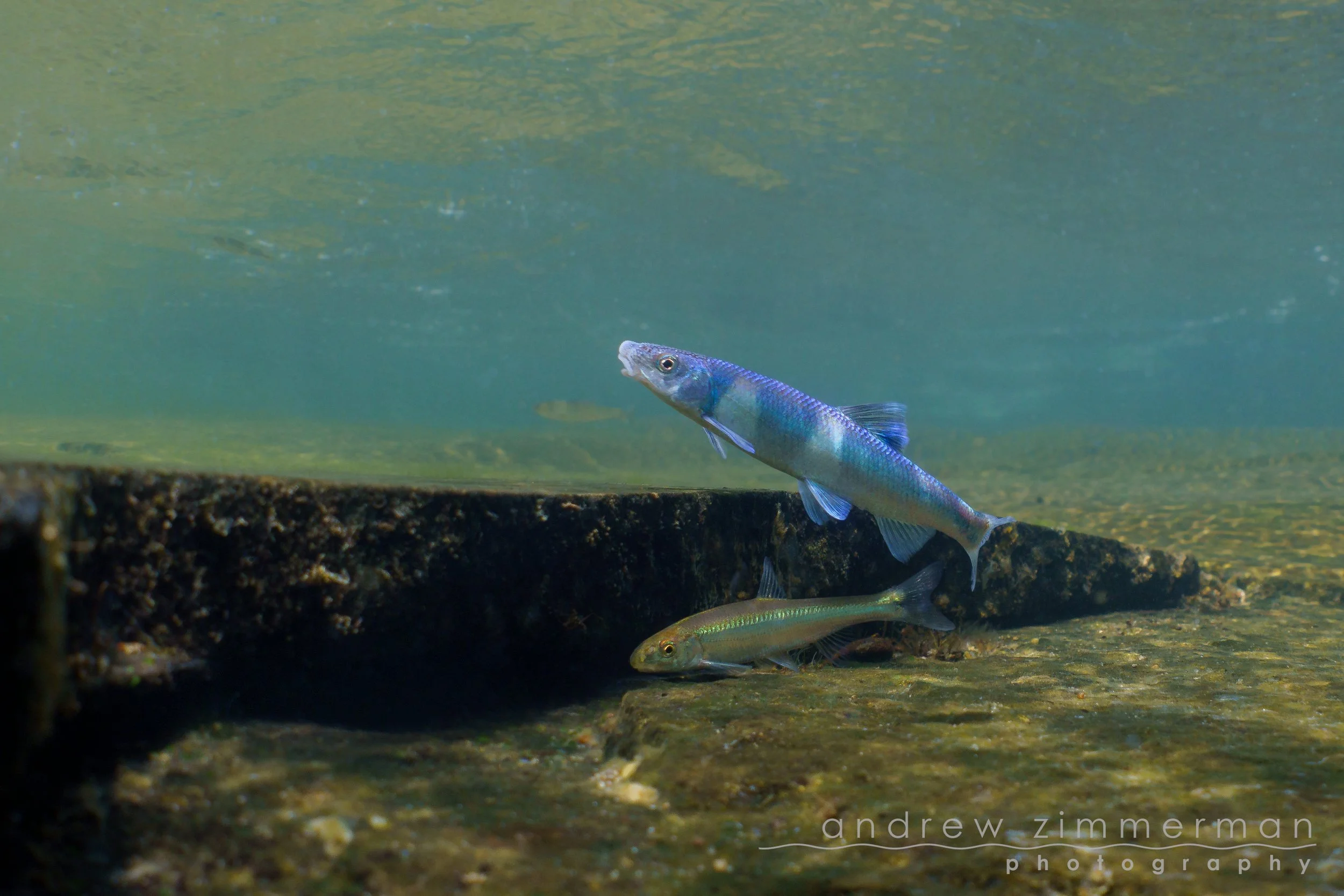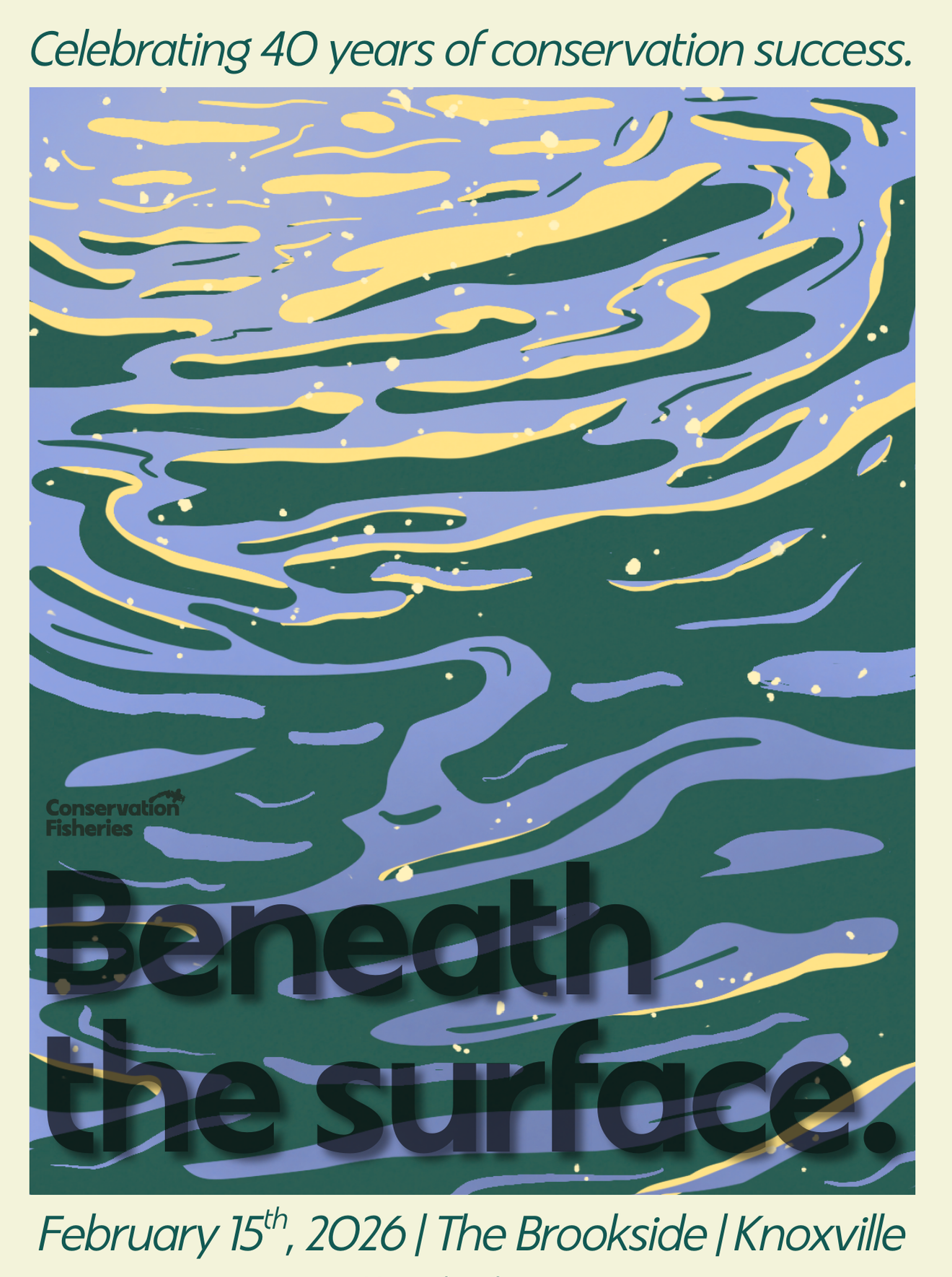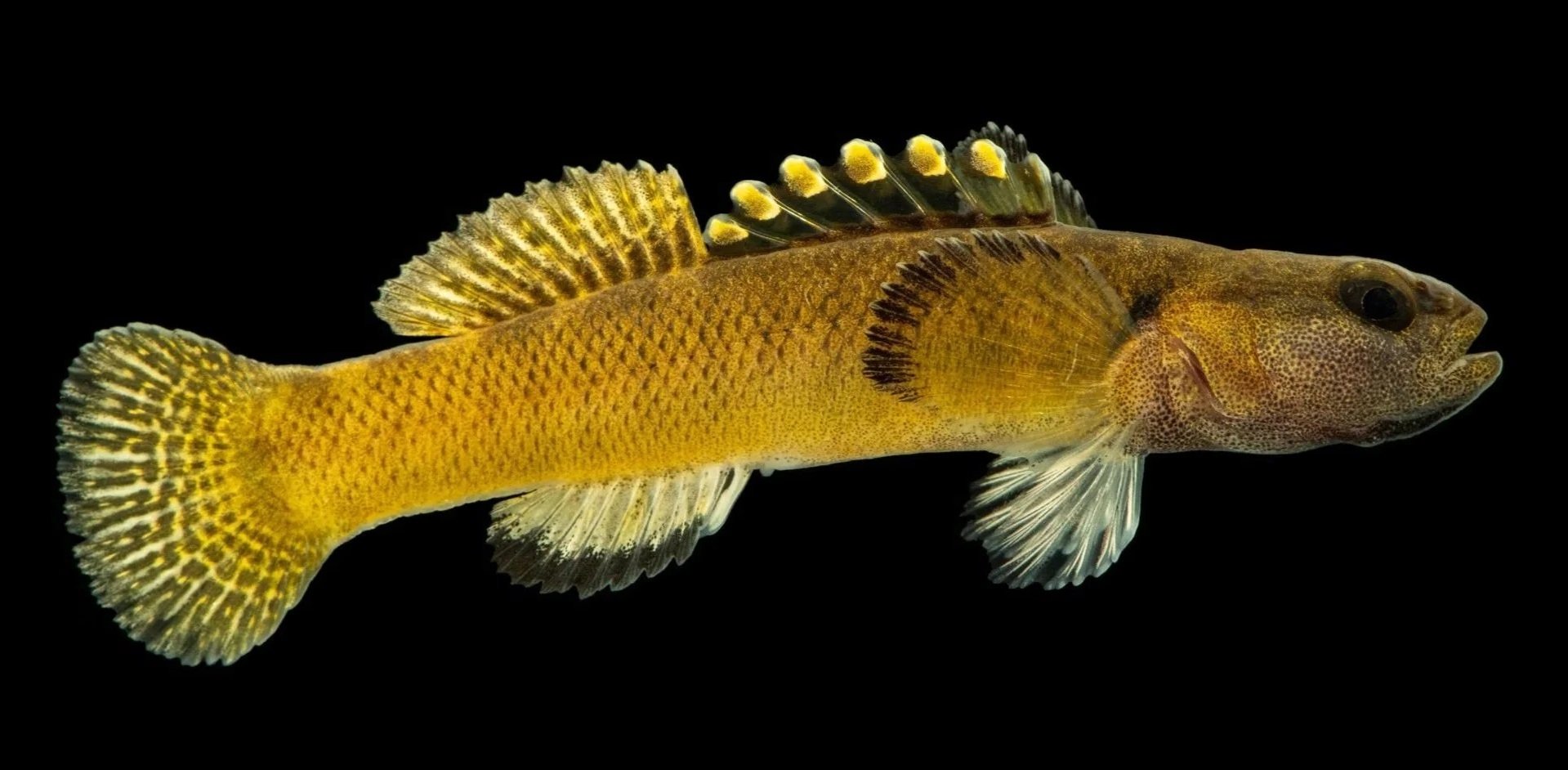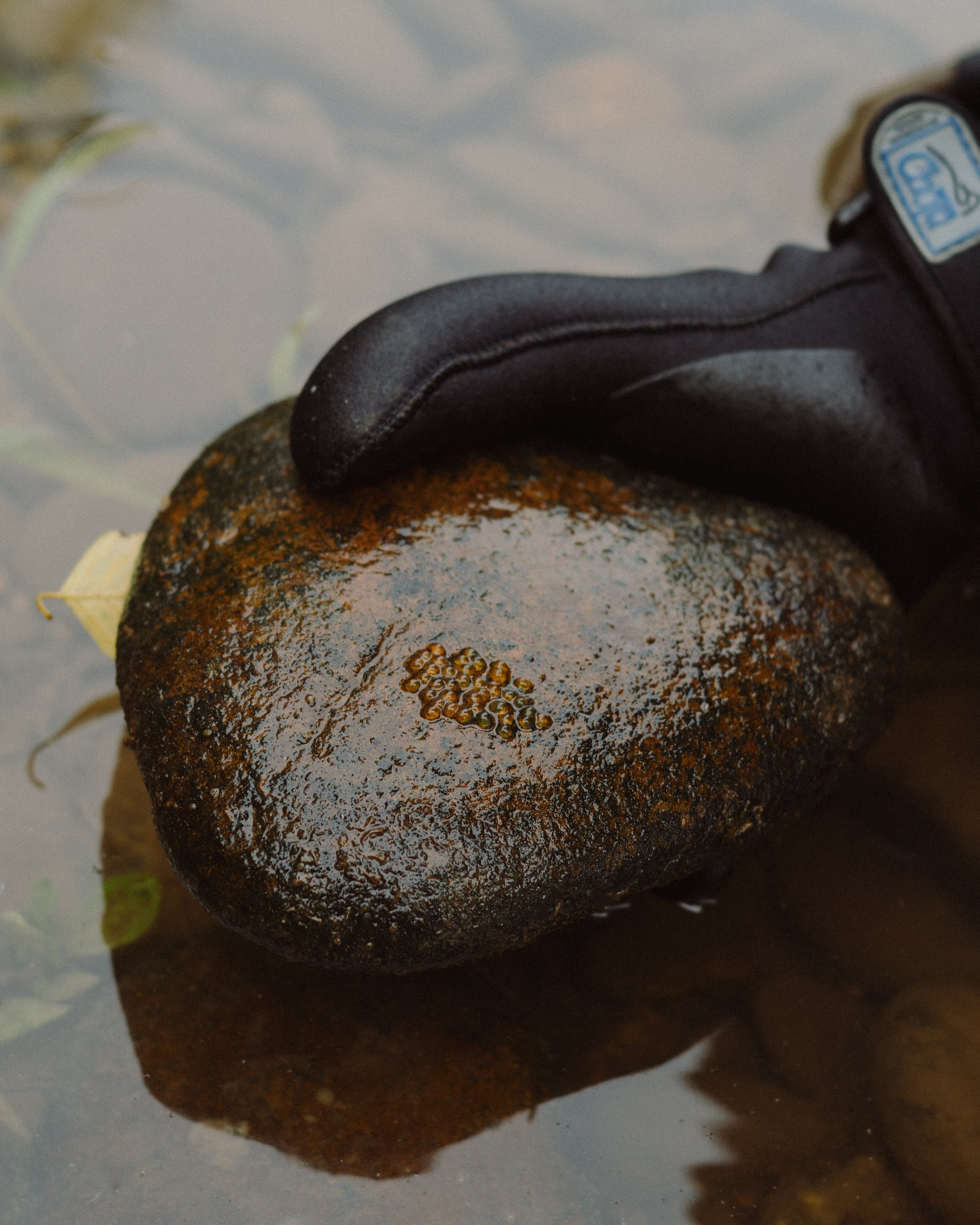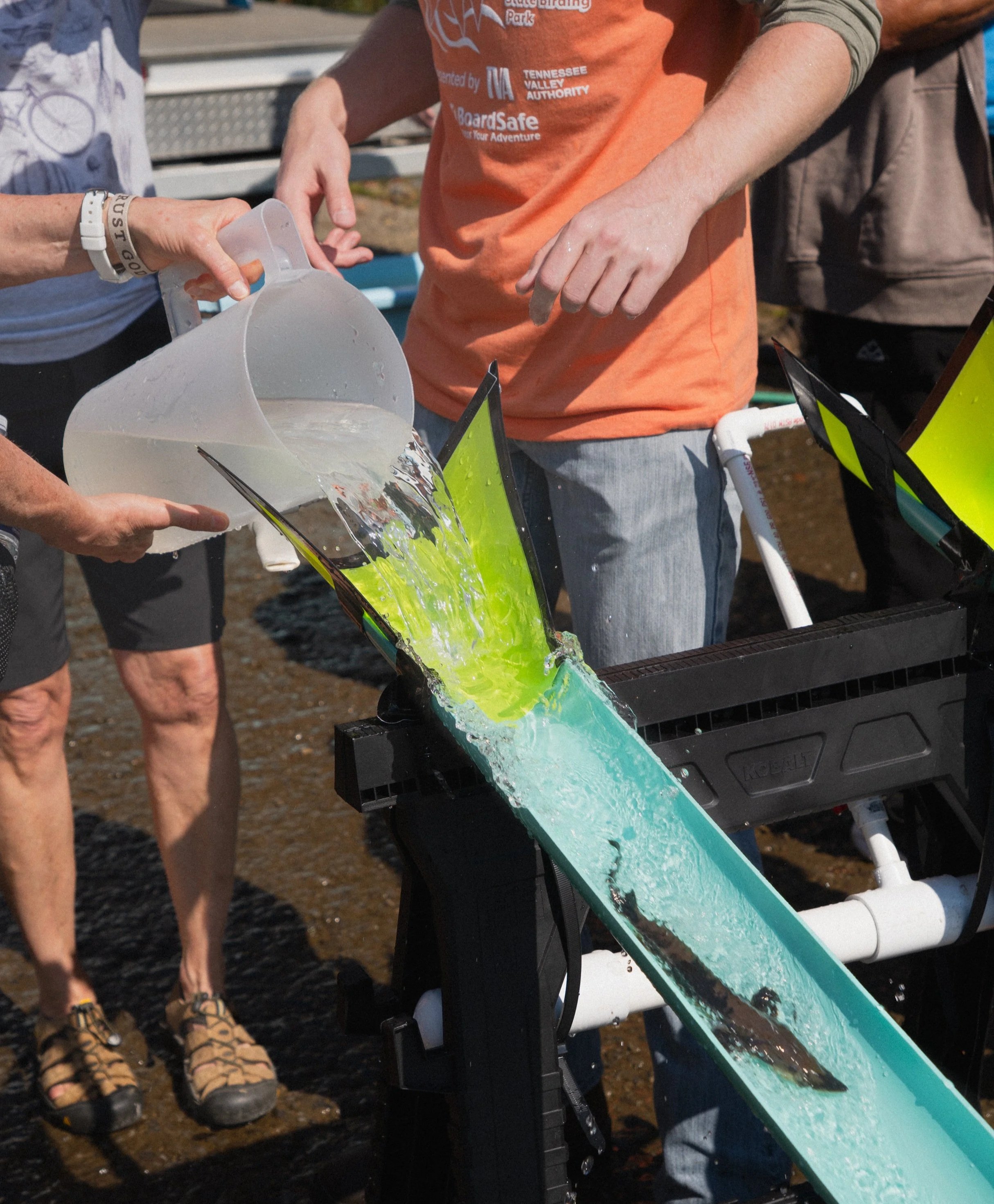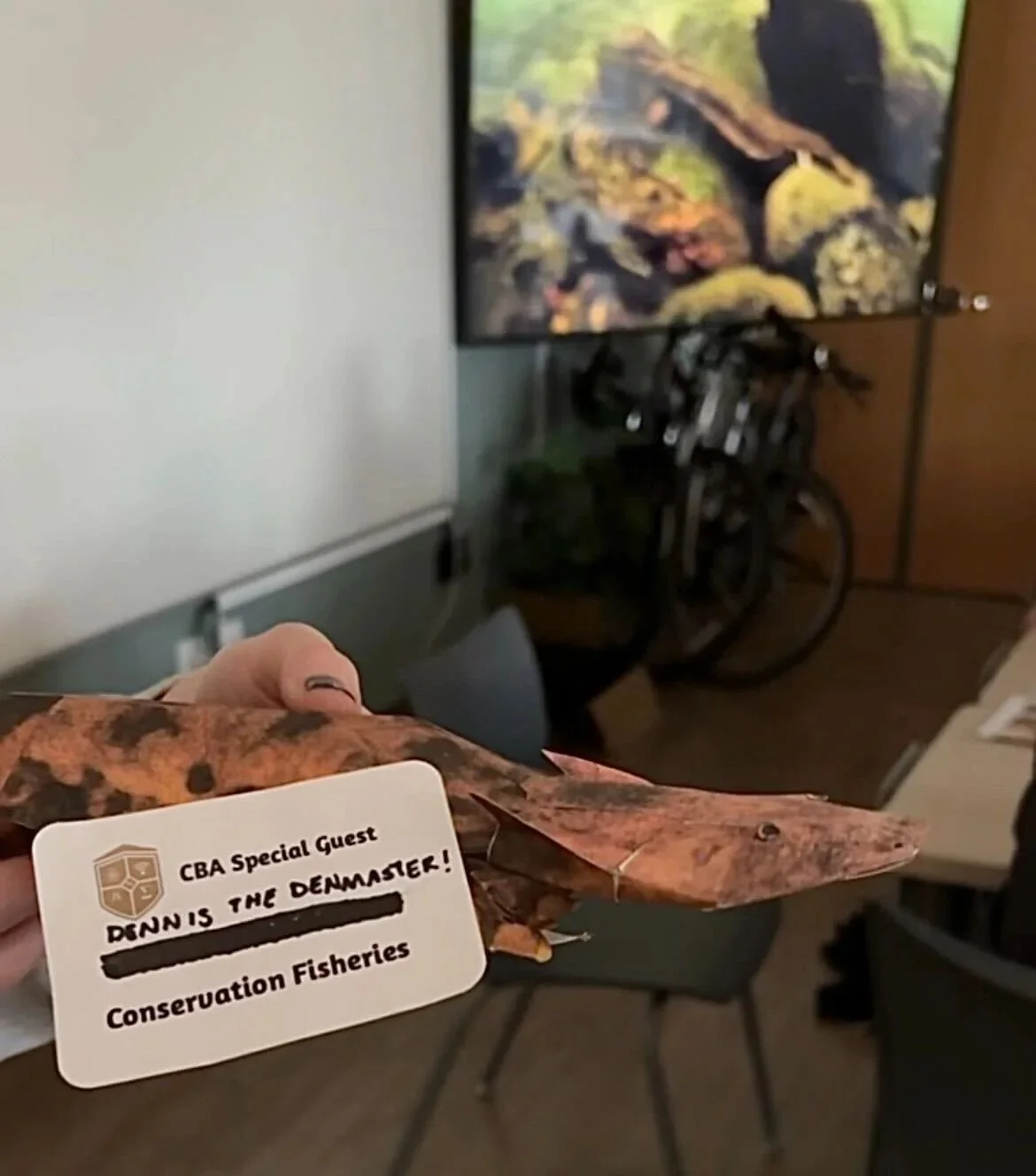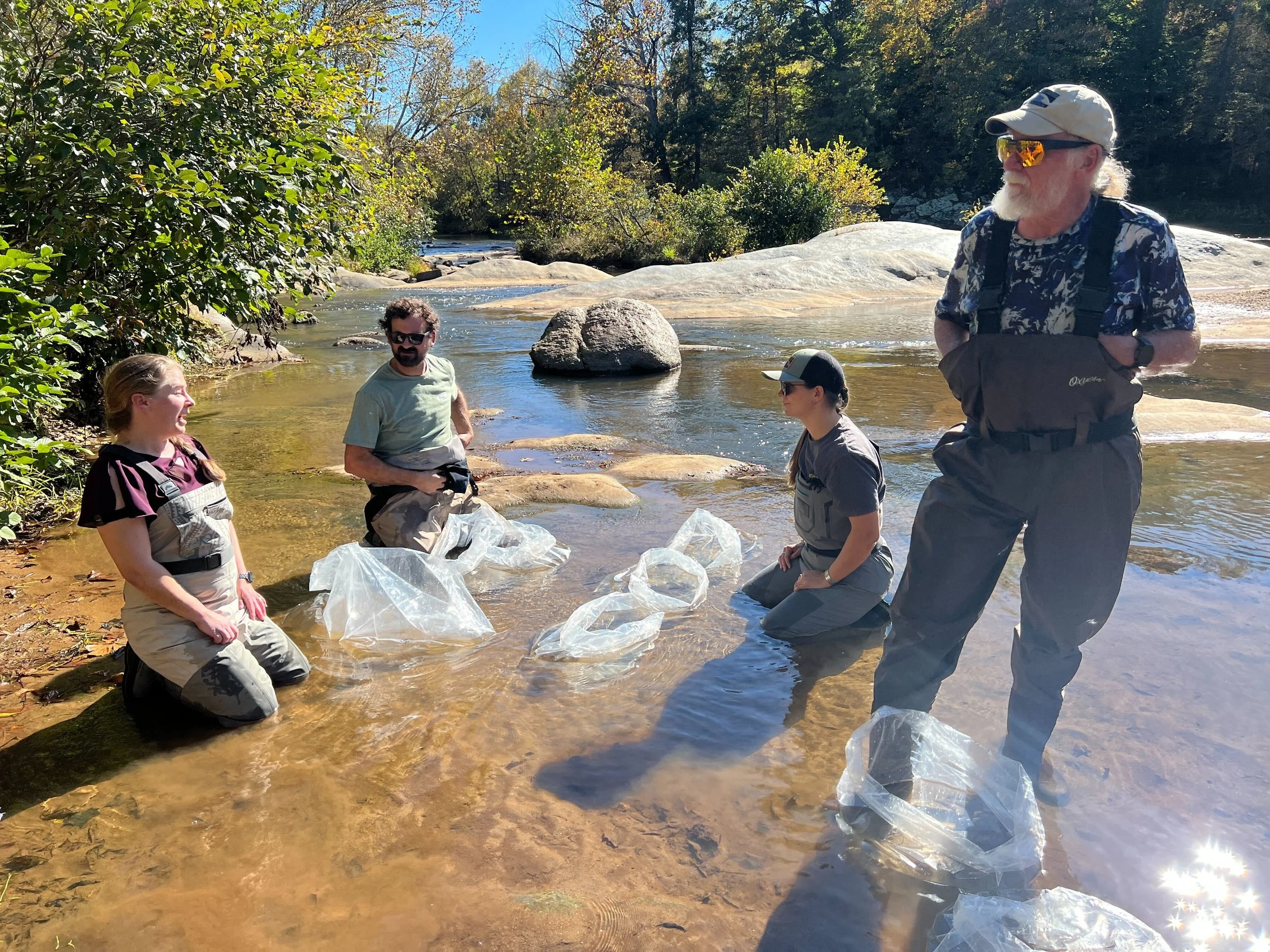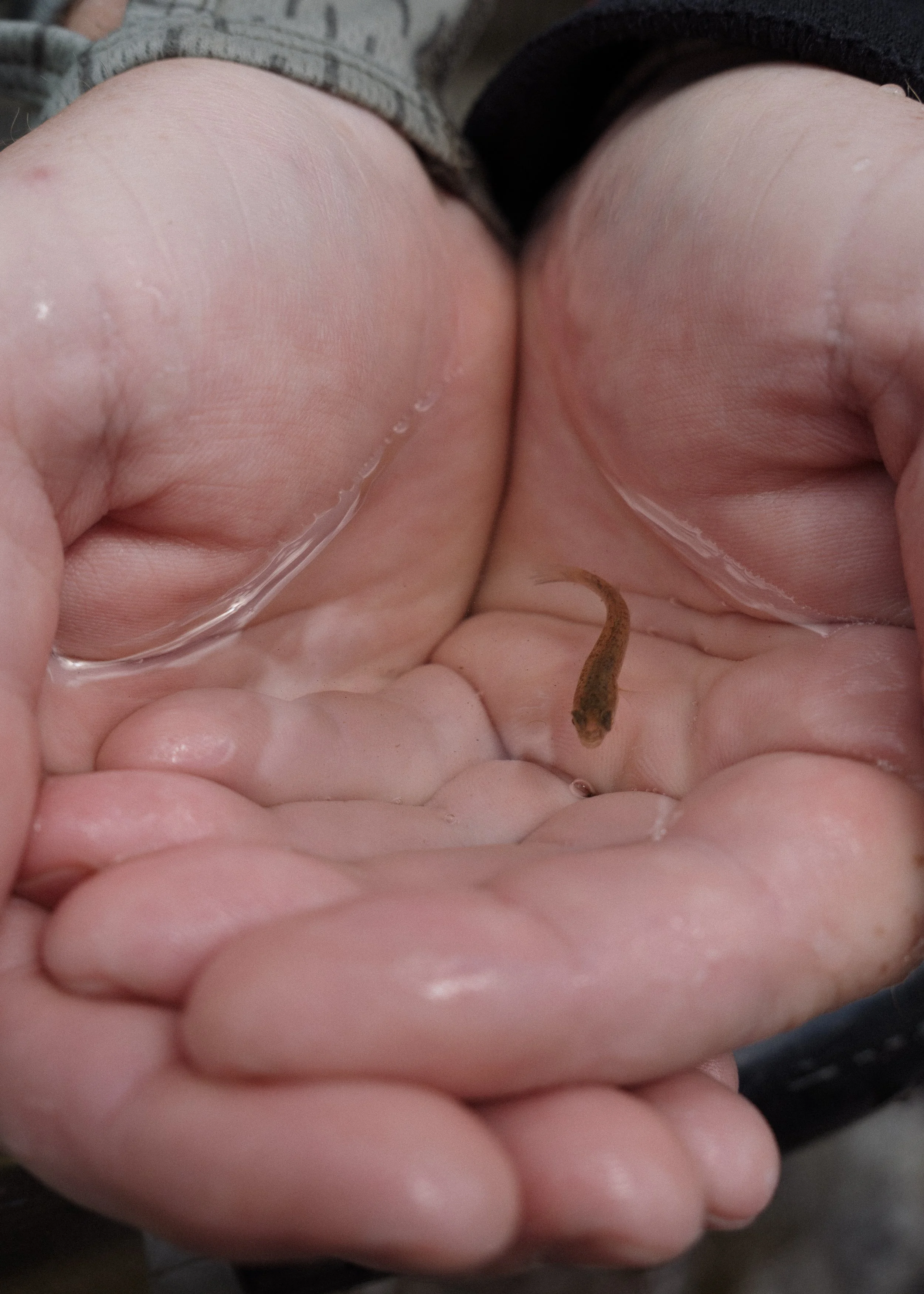Conservation Roundup: November 2025
Conservation Round-Up
Fall to Winter Season Transition
We are at the point in the year where Conservation Fisheries is planning field days to release the remainder of the fish that were spawned in our facility this year. The winter is an important season for fish in the wild as the decrease in water temperature triggers seasonal behavior in many species. Most fish species have a lower feeding response in the winter. As they are less active in the cooler temperatures, it requires less energy, and therefore a lower caloric need for the individual. In some species, as the water temperature cools, fish will seek out a warmer area of the stream to spend the winter. Species like Spotfin Chubs will migrate to spring-fed upwellings in the stream that release water from underground that is warmer than the temperature of the stream.
While we aim to get most of our propagated fish out into the wild by the end of the year, we do “overwinter” many of our fish that are slated to be breeders for the upcoming spring season. Sometimes these fish are collected from the wild in the fall season, and some are propagated individuals. Experiencing the temperature shifts from warm to cool, and back to warm again in the same location that they will be spawning is often less stressful on the fish than collecting them so close to their spawning season. Less stress can often mean a more successful reproductive season. To ensure that fish in our facility experience the same thermal shifts that they would in the wild, we drop our facility temperatures drastically in the winter. This ensures that these fish go through the proper internal changes to allow for egg and gamete production for a fruitful spawning season.
Since Conservation Fisheries is housing so few fish during this season, our team’s attention is often focused on report writing and planning for the upcoming spring spawning season. At year’s end we send reports to our partners and funding agencies regarding the work we did this year, focusing on things like production numbers and field observations. This allows us time to reflect on the successful year we’ve had, and push us through the remainder of the winter season before starting it all over again next year!
Volunteer Program
Our Volunteer Program is experiencing a transition! Since its inception in 2021, this program has been run by one of our Conservation Biologist, Shannon Murphy. She developed the program and has thoroughly enjoyed mentoring and working with our student volunteers. In an effort to redirect her focus back to fish propagation, the role of the Volunteer Coordinator is being reallocated under the Education Outreach Coordinator’s responsibilities. Marley Borham has been in this role since 2024 and is a former member of the Volunteer Program herself! We couldn’t imagine a better person to transfer this responsibility to and are looking forward to seeing the impact that Marley has on this program.
Our next Volunteer Season will be from February 2026-April 2026. Applications for this season will open the first week of January and can be found on the Volunteer Program page of our website as well as through our social media pages.
Save the Date
November 8th-9th: Flash Tattoo Weekend at Saint Tattoo in Knoxville
Join us for our 2nd annual Fish Flash Tattoo d̶a̶y̶ WEEKEND! This two day event will last from 12pm-8pm each day with tons of artists and their original art inspired by our local biodiversity. Keep an eye on our social medias for sneak previews of the flash sheets!
Check out the folks from Saint Tattoo:
@doccooper_saint_tattoo; @fogfromthebog; @davistattooer; @bradgrubb; @thereal_tattoobradley; @douglasjtattoo
December 1st: Giving Day
The first Tuesday after Thanksgiving is recognized as an annual day of giving, highlighting the important and vital work that is done by non-profits around the nation. Conservation Fisheries is extremely proud of the crucial role that we play in the restoration of freshwater biodiversity in the southeastern United States. If you find our work meaningful, please consider supporting us on this Giving Day.
December 5th: Streamside: An Art Showcase of Appalachia’s Biodiversity
Join us next month for another art gallery featuring photography, mixed media, and more from Conservation Fisheries biologists and our talented friends! This year’s showcase will be hosted at Ironwood Studios - 119 Jennings Ave, Knoxville, TN 37917 and is free to attend.
February 16th, 2026: Beneath the Surface - A Dinner Celebrating 40 Years of Conservation Success
Join us Sunday, February 15th, 2026 at The Brookside for our annual Winter Dinner, Beneath the Surface!
This year we are celebrating 40 years of conservation success. Together we will look back on the stories, people, and achievements that have shaped our journey, and look ahead to all that’s still possible.
We’ll enjoy a delicious meal from Knoxville’s own Tarik’s North African and hear from keynote speaker Emily Graslie who will help us celebrate this remarkable 40-year milestone.
We can’t wait to gather with you for an evening full of community, gratitude, and hope as we continue supporting our rivers beneath the surface, one bite at a time.
Species Spotlight
Marbled Darter, Etheostoma marmorpinnum
What has two pectoral fins and looks like it’s got fish eggs on its back?? The Marbled Darter!
Actually, the Marbled Darter is a member of a group of fish often referred to as “egg-mimic darters” because of the round knobs on their dorsal fin spines that look like eggs! Male Marbled Darters, and other egg-mimic darters, will burrow themselves underneath a rock, scoping out a potential mate. When a female passes by, the male will flare his dorsal fin to make it look like there are eggs above his head, on the underside of the rock, to trick the female into thinking he is already tending to a nest. This demonstrates that he is already providing good parental care to a nest of eggs. The female will then join the male under the rock, flip her whole body upside down, and lay her eggs on the rock! She will then leave the male to guard and groom the nest, ensuring the egg’s survival until they hatch.
Marbled Darters, along with two other species (Citico Darters and Tuxedo Darters) were all once considered to be Duskytail Darters, which was listed as Endangered in 1993. All four species look so similar, that if you put them all together in a fish tank you wouldn’t be able to tell them apart just by looking at them! They can only be told apart by their genetics and native range. In 2008, after a study was done on all four “ disjunct populations” of the “Duskytail Darter”, it was determined that they were so genetically separate as to be four different species! While the native range of all four species was once connected, geographical changes cut off connectivity between each of them, allowing them to eventually evolve into genetically different species. Additionally, since the Duskytail Darter was listed as Endangered during this taxonomic split, the Marbled, Citico, and Tuxedo Darters are all listed as Endangered under the Duskytail Darter’s name.
Marbled Darters occupy a small range in only one river in East Tennessee. Based on historic river records biologists can assume where they may have occurred before, and therefore Conservation Fisheries is working toward extending Marbled Darter’s range into the French Broad River in partnership with Seven Islands Foundation, Seven Islands State Birding Park, Tennessee Wildlife Resources Agency, US Fish and Wildlife Service, The Nature Conservancy (with funding from Bonneville Environmental Foundation and the Arconic Foundation) and Tennessee Valley Authority. We began this restoration effort last year, but after Hurricane Helene’s impact on the French Broad River last fall, this will be the first year that Marbled Darter’s will be released into this river.
Community Outreach
Sturgeon Fest
We were thrilled to join our friends at Seven Islands State Birding Park for this year's Sturgeon Fest! Hosted annually by the Friends of Seven Islands and TVA in collaboration with Warms Springs National Fish Hatchery, this event brings the community together for a fun-filled day of music, food, local vendors, and most exciting of all, the chance to release a juvenile sturgeon into the French Broad River.
Participants didn’t just release their sturgeon, they did so in style! For the past two years, the released sturgeon made their river debut via waterslide, designed by our very own Bo Baxter, adding an extra splash of excitement!
We love being part of this event and celebrating the return of lake sturgeon to the waters of East Tennessee!
CBA Pistol Creek Day
We were once again invited to Clayton-Bradley Academy for their Pistol Creek Day! This is a day for students of all ages to get involved and learn about how their actions impact their local watershed, including Pistol Creek which circles their campus.
In the past Conservation Fisheries had the opportunity to get all of the 8th grade class into Pistol Creek to survey the fish they have right on campus. Unfortunately, this year was interrupted by a day of rain so we moved the fun indoors! We introduced the 8th grade class to the Freshwaters Illustrated film The Last Dragons, which focuses on the Eastern Hellbender.
Along with watching the short film, the students had the chance to build their own hellbender out of paper. Despite not being outside in the creek, we had a great time introducing the students to the last dragons of Appalachia!
Tennessee Wildlife Resources Agency Biodiversity Summit
Conservation Fisheries had the opportunity to attend TWRA’s inaugural Biodiversity Summit at Middle Tennessee State University. We joined conservation professionals from both aquatic and terrestrial fields to discuss the important work happening in our respective fields. Our Director, Bo Baxter, was asked to give a talk on the work that Conservation Fisheries and our partners across the state are doing to advance freshwater biodiversity through population restoration in Tennessee.
Season Highlights
First Release of Roanoke Logperch Since Delisting
Earlier this year it was announced that, due to restoration and recovery efforts, the Roanoke Logperch was delisted from the Endangered Species List! Conservation Fisheries has been a partner in this long-term restoration effort, propagating this species in our facility to release into restored, wild habitats. This year was no different, and we completed our first release of Roanoke Logperch since their delisting. North Carolina remains committed to restoring this species to as many streams in its historical range as possible. We’re extremely proud of all of the partners that worked tirelessly to make this delisting happen, and are proud of the critical role we played in the conservation of this species.
Conservation Fisheries x Dale Hollow National Fish Hatchery
Conservation Fisheries has teamed up with the U.S. Fish and Wildlife Service to build a facility at the Dale Hollow National Fish Hatchery that will focus on the restoration of non-game species local to Middle Tennessee. Construction on the facility happened earlier this year. Conservation Fisheries and USFWS have been working hard to finish out the interior of the building, and we will be sending one of our biologists to begin operations next month!
Hellbenders in the House!!
Conservation Fisheries has been given the incredible opportunity to work with North America’s largest salamander, the Eastern Hellbender! Conservation Fisheries join the teams at the Chattanooga, Nashville, and St. Louis Zoos working on the conservation of this species after Hurricane Helene’s impact on their habitat in 2024 increased the need for this important work. We collected eggs from the wild with the help of our partners at the US Forest Service, brought them back to our facility, and have been eagerly watching them hatch from their very large egg sacks. We can’t wait to experience their larval development over the next few months!
Partner Feature
U.S. Fish and Wildlife Service
The U.S. Fish and Wildlife Service (USFWS) works with others to conserve, protect, and enhance fish, wildlife, plants, and their habitats for the continuing benefit of the American people. They aim to protect the natural world so current and future generations can live with, live from, and find awe in lands, waters, and wildlife.
Conservation Fisheries has been working with the USFWS since our early days propagating Yellowfin and Smoky madtoms for Abrams Creek Restoration in the Great Smoky Mountains National Park. Our partnership with the Service is essential, as our work with Threatened and Endangered Species requires special permitting of these animals given their federal listing status.
Our partnership is more than just permitting, though. We keep in regular contact with the Species Leads and other USFWS biologists managing these endangered species, often discussing future plans and best practices that will most benefit the conservation projects that we work on together. USFWS biologists hold important roles in working groups focused on individual species, collecting information from the biologists working hands on with the species, and offering guidance on the direction these projects should be taking.
With the recent government shutdown, USFWS biologists have been unable to contribute to these projects and conversations, and we are certainly feeling their absence. Project-focused calls and field days have been put on hold, and we’ve missed them at in-person meetings and conferences. We stand in solidarity with all biologists at the U.S. Fish and Wildlife Service and look forward to welcoming them back into the important conversations that require their knowledge and expertise for the betterment of endangered species throughout the country.
Gratitude
Contributions
Many thanks to all of the Conservation Fisheries staff members that contribute ideas for the newsletter as well as photographs of our field and facility work, especially of the beautiful fish that we have the pleasure of working with every day. Thank you as always to Joel Sartore, who has taken brilliant photographs of our species for years which appear constantly throughout our website and newsletters. Information about outreach and events are thanks to Marley and Aster. Thanks to Bo, who has countless things to do as our Director but will always give feedback on the newsletter draft.
From Our Team
As always, the biggest thanks to the folks who find value in the work that Conservation Fisheries does on a daily basis. If our work speaks to you, please consider supporting us on Giving Day this December 1st. Other support, such as liking our social media posts or stopping by our outreach booths and events, means the world to us, too. Thank you all for loving the fish as much as we do.
— The Conservation Fisheries Team



